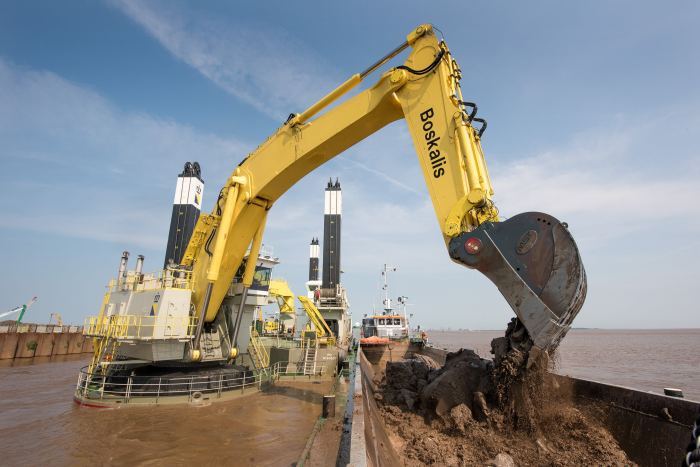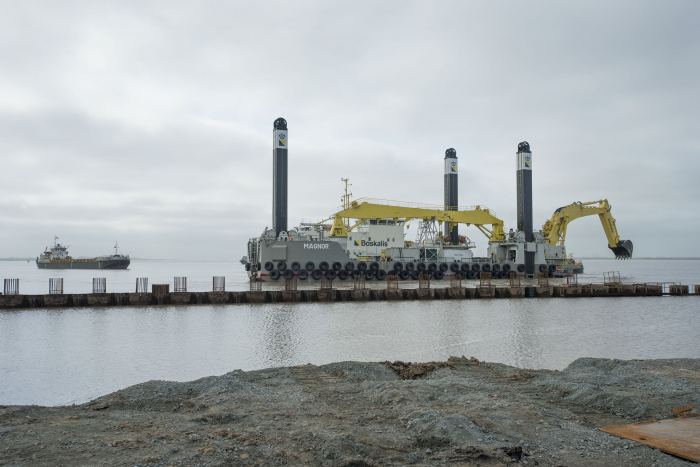Boskalis now has the largest and most efficient backhoe dredger in the world: the new, awe-inspiring Magnor. The specific design and the innovations developed by Boskalis for the excavator and the lifting section make the Magnor fast, powerful, economical, clean and quiet.
Think of a 20-foot container. It has a volume of about 33 m3. That volume can fit in the bucket on the backhoe dredger Magnor with another 4 m3 to spare. With a total capacity of 4,100 kW, the Magnor’s bucket will be able to lift no less than 67,000 kilograms of dredged material. “Backhoes are used for dredging in hard ground, especially when working with smaller volumes, and for dredging landfalls and trenches,” says David Cuninghame, the project leader responsible for the construction of the Magnor. “Backhoes are also being used increasingly for environmental reasons because they minimize turbidity.”
Powerhouse
With a length of 72 meters, a breadth of nearly 20.5 meters and 40-meter-long spuds, the new backhoe is a gigantic powerhouse. The design of the Magnor is based on the Baldur, now the second-largest Boskalis backhoe, which was also developed in-house. Thanks to a tapered bow, this type of backhoe can be towed faster than traditional backhoes to any location in the world. “With the smaller backhoes, the cost per cubic meter dredged is higher than with the larger types,” explains David. “So we are replacing our smaller types with larger and more efficient backhoes. We made a deliberate decision not to buy backhoes ‘off the peg’ like many other companies, but to design and build the backhoes ourselves. That approach is unique and it gives us a major advantage.”
Water cooling
The Magnor has a BK 12700 DD Greenline excavator, which is based on the largest mining machine on the market today, the Caterpillar 6090. The name ‘Greenline’ reflects the fact that the machine has low fuel consumption and reduced emissions of harmful substances. A Boskalis team led by engineer Bas Veenstra modified and assembled the entire excavator. The complete lifting section with the boom, the stick, the hydraulic cylinders and different sizes of buckets were developed in house. “We drew on all our knowledge and experience of hydraulic, mechanical and electrical systems,” says Bas. “We developed a totally new concept for the boom – the split boom system – that allows us to change the entire lifting section in no time during operations.” Another highly effective innovation is the use of water cooling for the engines and hydraulics. “It not only delivers significant improvements in terms of fuel consumption and emissions, it also limits noise levels. That is a major advantage because more and more clients have strict requirements for sound levels on projects,” explains Bas.

Automatic mooring
Bas was also the inventor of another novelty: the Mooring Actuator. This innovative system renders manual mooring with lines obsolete. “The Mooring Actuator maneuvers the barges alongside the backhoe without a hitch and provides a stable connection during the loading operation. That is efficient and, above all, safe,” he explains. “That is why Boskalis is installing this efficient mooring system on other vessels in the fleet as well.”

‘The Fighter’
Unlike other backhoes, the Magnor has accommodation for the specialized crew consisting of eight men. “That makes it possible to deploy the Magnor on operations in even the most inhospitable regions,” says Arjan Schrijen. As Fleet Manager, he is responsible for the Boskalis backhoes and grab dredgers. “Many of our backhoes, such as the Baldur and Wodan, have names that come from Norse mythology,” he continues. “Magnor means ‘The Fighter’. The first projects with the Magnor were in the United Kingdom and Colombia. During those projects, we achieved good results in terms of speed, fuel consumption and emission reductions. That impressive level of performance has justified the Magnor’s name many times over.”
